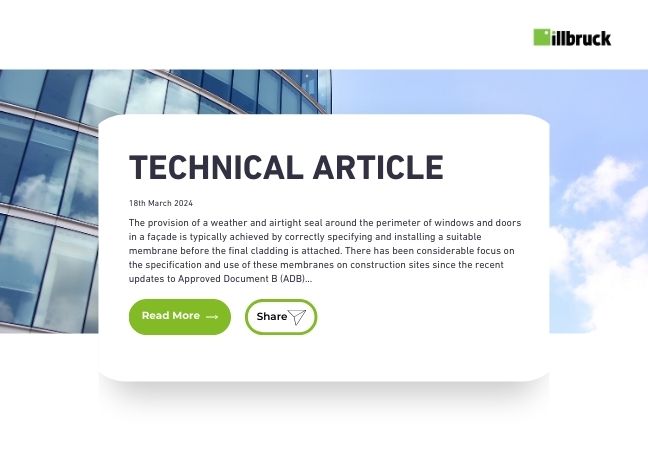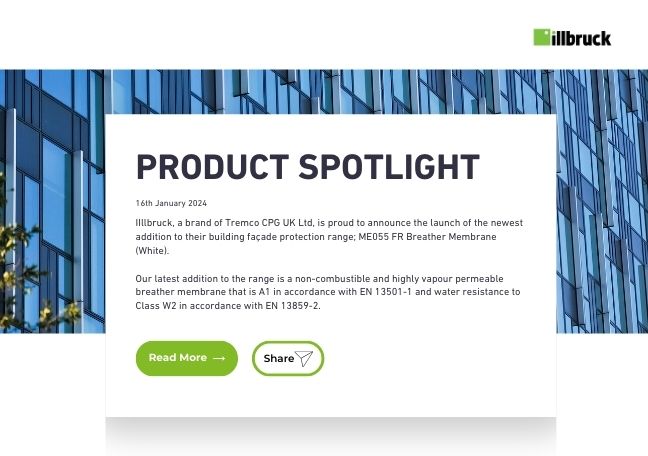What should one consider when specifying a Breather Membrane or Air and Vapour Control Layer?
Selecting the correct type of membrane and its position in a wall build-up is vitally important, especially when meeting the fire requirements of the Building Regulations, due to a building’s height or use. Following the recent amendments to the various national Building Regulations, the use of some traditional membrane types in many defined buildings are no longer deemed acceptable. The tightening of fire safety regulations has led to a ban on combustible cladding on these building types and further limitations on the fire performance requirements for all materials which form part of an external wall.
Guidance outlined in Approved Document B (ADB) for habitable dwellings over 18 m in height requires that all materials used in the external wall should have a reaction to fire classification of A2-s1, d0 or A1 in accordance with BS EN 13501-1. ADB also lists several exemptions to this rule which currently includes the use of membranes and seals.
Membranes used as part of the external wall construction, in these defined constructions, should however now achieve a minimum Class B-s3, d0 fire classification, whilst no minimum performance criteria have yet been defined for seals, such as linear jointing tape, sealants etc. However, whilst fire is a major consideration when specifying any membrane, it is still important to remember that the primary function of these membrane types is to manage the movement of air and moisture in a building following the guidance provided in BS 5250 Management of Moisture in Buildings – Code of Practice. This standard provides recommendations based on a combination of prescriptive modelling (such as WU-FI) and established building physics principles to ensure that membranes are correctly specified and positioned in a construction.
There are two main types of membranes which are commonly specified in an external wall construction - breather membranes and air and vapour control layers. Both are used to control the movement of moisture to ensure that condensation does not occur or accumulate within the building’s fabric, where there is a potential to cause dampness and promote mould growth or contribute to rot or corrosion of structural elements.
Breather membranes can be designed to:
- Resist water from wind driven rain – protecting the building fabric from the elements during the construction phase and to the sheathing/insulation layers during the service life of a building.
- Remain highly breathable – enabling any trapped water or moisture to escape from the building’s fabric to the outside environment.
- Be installed on the external side of the wall construction, either over the sheathing for closed cladding facades or over the insulating layer for open rainscreen type claddings.
- Be weather and airtight, thus adding an important functional layer to protect the building.
- Be permanently UV stable for use behind open cladding systems.
- Meet or exceed the fire classification requirements of the national Building Regulations.
Air and Vapour Control Layers (VCL’s) are designed to:
- Control moisture moving outwards from internal habitable space into the building’s fabric.
- Be highly vapour resistant so that moisture cannot track to the internal layers of the construction.
- Be used as the primary airtightness layer.
- Be installed on the “warm” side of the insulation layer.
- Meet or exceed the fire classification requirements of the national Building Regulations.
Considerations when specifying a breather membrane:
Moisture Transfer –
Breather membranes are placed on the cold external side of a construction and provide protection during the construction phase and to the sheathing and insulation layers in service. They may also be installed over the insulation layer typically in cladding systems to provide additional protection against weather. They should comply with BS 5250, the Code of Practice for the management of moisture in buildings. Breather membranes must be sufficiently vapour open (sd value ≤ 0.12 m) to allow vapour in the building’s fabric to escape outwards.
Watertightness –
Not all breather membranes are designed to be totally water resistant and some will let a small amount of water through. Where permanent weather protection is required, such as in exposed locations, projects with a long construction duration, or when used in an open rainscreen cladding type application, the use of a fully water resistant membrane is essential (minimum Class W1 to EN 1928). A breather membrane with Class W2 water resistance may be used for projects in less exposed areas, with shorter construction durations and where it will be permanently protected by a weathertight closed cladding system.
Fire Performance –
Membranes specified for use within an external wall construction for “high-rise” or “high-risk” buildings must have a minimum fire classification of B-s3, d0. Whilst it may be tempting for some building designers to specify an A2-s1, d0 or even an A1 membrane type in an attempt to futureproof a construction, it is extremely important to consider the key factors below and select the membrane which is the most suitable for a specific structure or application. Best practice is to ensure that the key properties of the breather membrane meet with all the building requirements whilst still providing the best fire classification available.
UV Stability –
Where projects have an “open-jointed” cladding finish, it is very important that a membrane with sufficient UV stability is specified (tested after 5000 hours exposure to UV) to ensure it will continue to function for the service life of the cladding.
Airtightness –
Breather membranes can be designed to provide an airtight solution to the external side of the building. This can assist with the speed of the build or even the elimination of the requirement for an airtight layer on the internal side of the building.
Considerations when specifying an air and vapour control layer (AVCL):
Moisture Management –
AVCL’s have a very high resistance to vapour transfer and are installed on the warm internal side of the insulation and act to prevent the movement of moisture from the inside of a building into a building’s fabric – preventing the growth of mould or damp. It is important when specifying a VCL that proper jointing and sealing is considered in order to maintain the air and vapour tightness.
Fire Performance –
Best practice is to ensure that your VCL meets all the requirement of the national Buildings Regulations whilst providing the best fire classification available.
Airtightness –
VCL’s will most commonly act as the primary airtightness layer. Therefore, one should consider the airtightness properties of a specified VCL – to prevent heat loss and cold draughts from a building.
Specifying breather membranes and vapour control layers from illbruck will ensure that buildings across the UK breath, whilst allowing moisture to escape and comply with building regulations. For more information regarding the breather membranes and VCLs available through the illbruck brand, don’t hesitate to contact a member of the technical specification team today, or visit our website for more information.









